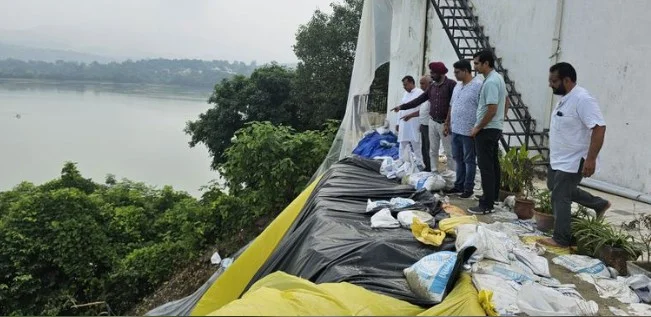NANGAL, Sept. 14 — A civil engineering team from IIT Ropar has identified poor drainage systems, faulty building designs and collapsed retaining walls as major factors behind recurring landslides in areas around Nangal Dam Lake, warning that habitations in Bhabhor village, the Laxmi Narayan Temple and adjoining localities remain vulnerable.
The team, which inspected the affected slopes on Sunday, said that poorly designed retaining walls had failed to provide stability, while unchecked water flow from septic tanks and structures was weakening hill edges.
“At most hill edges, where damaged houses are located, there is no drainage system. Wastewater from septic tanks and buildings flows directly into the supporting slopes,” Associate Professor Reet K. Tiwari of IIT Ropar’s Civil Engineering Department told The Tribune. “This, combined with heavy monsoon rains, increases the soil mass and triggers landslides, endangering habitations along the lake.”
Tiwari added that soil samples had been collected for geotechnical testing and simulation models were being developed. “Preliminary findings suggest that retaining walls built in stepped benches on solid foundations may help stabilise the slopes. A detailed report will be submitted to the Ropar district administration within three to four days,” he noted.
Geotechnical expert Dr. Naveen James, also part of the inspection, stressed that the high water flow in the Sutlej reservoir aggravated the threat. “Every new construction along riverbanks or sloped terrain must be preceded by technical surveys to assess structural safety,” he said, adding that regular inspections of existing structures were equally critical.
The experts recommended that the Punjab government make structural stability certifications mandatory for all new buildings near slopes and water bodies, to ensure long-term safety in sensitive areas.
The inspection followed a request from BJP state president Subhash Sharma, who had recently visited Bhabhor village and sought IIT Ropar’s intervention. Sharma assured residents that once the report was submitted, he would press the central government and the Bhakra Beas Management Board (BBMB) for a permanent solution.
Villagers, already grappling with damaged houses and public infrastructure, voiced hope that the technical report would lead to concrete measures. With monsoon-triggered landslides posing a recurring danger, experts said the coming weeks would be crucial for determining safeguards along the Nangal Dam Lake.

